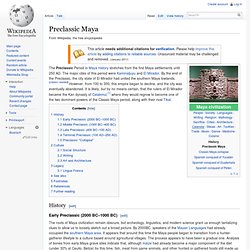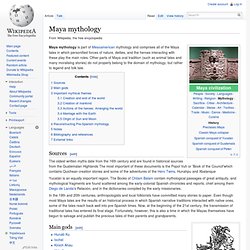

Classic Maya collapse. The Classic Maya Collapse refers to the decline of the Mayan Classic Period and abandonment of the Classic Period Maya cities of the southern Maya lowlands of Mesoamerica between the 8th and 9th centuries.

This should not be confused with the collapse of the Preclassic Maya in the 2nd century AD. The Classic Period of Mesoamerican chronology is generally defined as the period from AD 300 to 900, the last 100 years of which, from AD 800 to 900, are frequently referred to as the Terminal Classic.[1] The Classic Maya Collapse is one of the biggest mysteries in archaeology. The classic Maya urban centers of the southern lowlands, among them Palenque, Copán, Tikal, Calakmul and many others, went into decline during the 8th and 9th centuries and were abandoned shortly thereafter.
Archaeologically, this decline is indicated by the cessation of monumental inscriptions and the reduction of large-scale architectural construction at the primary urban centers of the classic period. Theories[edit] Preclassic Maya. The Preclassic Period in Maya history stretches from the first Maya settlements until 250 AD.

The major cites of this period were Kaminaljuyu and El Mirador. By the end of the Preclassic, the city state of El Mirador had united the southern Maya lowlands. [citation needed] However, from 100 to 300, this empire began to decline, and the city was eventually abandoned. It is likely, but by no means certain, that the rulers of El Mirador became the Kan dynasty of Calakmul,[1] where they would regrow to become one of the two dominant powers of the Classic Maya period, along with their rival Tikal. History[edit] Early Preclassic (2000 BC–1000 BC)[edit] Middle Preclassic (1000 BC–400 BC)[edit] By around the year 1000BC, centuries of agricultural village life had begun to form the beginnings of a complex society: Prestige goods such as obsidian mirrors and jade mosaics began to appear, increasing the demand for more extensive trade.
Late Preclassic (400 BC–100 AD)[edit] Preclassic "Collapse"[edit] Maya religion. The traditional Maya religion of Guatemala, Belize, western Honduras, and the Tabasco, Chiapas, and Yucatán regions of Mexico is a southeastern variant of Mesoamerican religion.

As is the case with many other contemporary Mesoamerican religions, it results from centuries of symbiosis with Roman Catholicism. When its pre-Spanish antecedents are taken into account, however, traditional Maya religion already exists for more than two millennia as a recognizably distinct phenomenon. Before the advent of Christianity, it was spread over many indigenous kingdoms, all with their own local traditions. Today, it coexists and interacts with pan-Mayan syncretism, the 're-invention of tradition' by the Pan-Maya movement, and Christianity in its various denominations. Sources of traditional Mayan religion[edit] What is known of pre-Spanish Maya religion stems from heterogeneous sources (the primary ones being of Maya origin): Fundamentals of ritual[edit] Ritual topography and calendrical mapping[edit]
Maya mythology. Maya mythology is part of Mesoamerican mythology and comprises all of the Maya tales in which personified forces of nature, deities, and the heroes interacting with these play the main roles.

Other parts of Maya oral tradition (such as animal tales and many moralising stories) do not properly belong to the domain of mythology, but rather to legend and folk tale. Sources[edit] The oldest written myths date from the 16th century and are found in historical sources from the Guatemalan Highlands The most important of these documents is the Popol Vuh or 'Book of the Council'which contains Quichean creation stories and some of the adventures of the Hero Twins, Hunahpu and Xbalanque Yucatán is an equally important region.
In the 19th and 20th centuries, anthropologists and local folklorists have committed many stories to paper. Main gods[edit] Important mythical themes[edit]